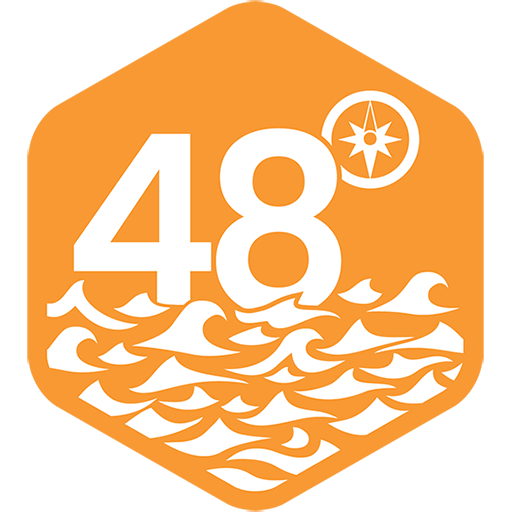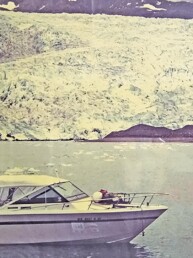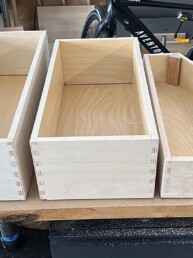 From the August 2010 issue of 48° North by Heather Lochner
From the August 2010 issue of 48° North by Heather Lochner
It was our first crossing of the season. The Gulf Islands beckoned us. With no wind in sight, we gave our rested engines a much needed workout. For a boat that had been tied up all winter long, the systems appeared to be running smoothly. That is, until we were halfway across the Strait of Georgia when suddenly our engine alarm sounded.
I’d like to say that we acted instantly, but that was not the case, and once our deer-in-the-headlights affliction faded, Tim throttled down and dashed below. Rushing to the engine room he discovered our raw water hose had sprung a leak. Try as we might, we couldn’t get tape to stick.
Looking around the boat, Tim found a spare inner tube. “What are you doing?” I squealed in horror. “An inner tube?” But my man was no lightweight in the engine room, he knew what to do. Wrapping the inner tube tightly around the hose, he was able to staunch the leak in short order. It even looked cool! He MacGyvered that tube and used it to fix our gushing water problem. I would never have thought of that.
For those of you who may not remember, Angus MacGyver, from the hit TV show MacGyver, was a secret agent with a cool head, a Swiss Army Knife, some duct tape, and an uncanny ability to jury rig complex, life saving devices using common materials. MacGyver may have been secret agent man, but he should have been a sailor!
But just in case the MacGyver in you is lying dormant, here are a few ideas. These will help kick start your ability to turn one thing into another. “The key is not to panic when something goes wrong”, says Ian Hursh owner of Ian Hursh Custom Woodworking. “Look around your boat and see what you have. A bit of imagination can go a long way.”
Hursh likes the example of bamboo skewers, a fairly common kitchen gadget that many boaters have onboard. Planning on using them for shrimp on the barbecue? Be sure to keep a few on hand. They make a great tool when fixing tired old screw holes. Basically take out the old screw, jam a skewer into the worn out hole, add some epoxy and let it harden, then cut off any residue and skewer not in use. Simple right? And don’t forget that bottle of wine you opened last night while peacefully at anchor. The cork can act as an emergency bung.
But Hursh’s ideas don’t end with the galley. Your pre-planning can be a life and boat saver when an emergency strikes. “These are just a few items that will help deal with breakdowns or emergencies at sea or at the dock,” explains Hursh. “Just be sure to carry an assortment of them.”
1. Assorted threaded rod, nuts and washers in different sizes, 1/4”, 5/16”, 3/8”. These can be used to replace damaged or broken bolts. Simply spin the nuts on, cut to desired length and then spin the nuts off to clean the threads.
2. Assorted hose clamps which can be used individually, doubled or tripled, depending on the size of the clamping application. Needing to jury rig a cracked or broken boom? Grab your boat hook (or the handle from your deck brush) a few clamps and you’ve MacGyvered a temporary solution. Do you have a broken bracket? This is the job for a clamp.
3. Assorted bits of hose and inner tubes should always be kept aboard. They can perform as patches and gaskets for punctured or leaking hoses or fittings. You can also combine them with electrical ties or duct tape to act as an anti-chafe device.
4. Assorted tape and electrical ties such as duct, electrical (strong and flexible), and self amalgamating. They come in handy for binding or can be used as a third hand, holding an item securely in place.
5. Assorted wood, metal (flat bar, angle, aluminum or steel) for temporary fixes. An aluminum angle drilled and fitted with appropriately spaced bolts can replace a misplaced pin wrench for two-hole deck filler caps.
6. Modeling clay (such as Plasticine) is ideal as a small leak filler for deck fittings, and ports. Best of all, it cleans up easily with Varsol.
While you may be unsure of some of these examples, Hursh knows firsthand what he is talking about. “I have been a MacGyver at sea,” he explains. “Janet and I once hose clamped rubber gloves over the leaking endplate of a heat exchanger. This helped our old boat limp home without overheating.”
Hursh is quick to emphasize the need to keep your tool kit fully equipped. Being a good MacGyver is also about being prepared, making sure you have all the gadgets you need to make something from nothing. Hursh recommends your tool box contain: Pic-Quic screwdriver, vise grips, assorted wrenches & Allen keys (appropriate to your boat), good quality side cutters, hacksaw, razor knife, a hammer, slip-joint pliers, files-rasp, axe file, rattail, and appropriate taps and drill bits- ¼-20, 8-32, 10-24. Lastly says Hursh, “carry a cordless drill and make sure you have charged batteries!”
Offshore cruisers Diane Selkirk and Evan Gatehouse have a similar list to Hursh but have added a few items; such as epoxy, thickening agents and fiberglass cloth. They also carry 1/8” spectra single braid. “It’s insanely strong for the size,” exclaims Gatehouse. “I am now using it to lash blocks everywhere instead of shackles. It works well, since I can put a block anywhere there is a strong point. It’s also very useful for jury rigged solutions.”
When asked about one of his finest MacGyvering moments, Gatehouse recalls the story of a time when they were sailing in Mexico and the metal exhaust elbow on their boat developed a leak. “I cut apart a tin can and then used some stainless steel seizing wire to lash it in place over the hole. It wasn’t perfect but lasted the miles we motored to a small village where I prowled through a junkyard looking for bits to weld up as a replacement.”
Sometimes being truly a good MacGyver is as simple as looking at your clothes. Just ask Craig Alward from the company, Keel and Rudder (www.keelandrudder.com). “This goes back to my early sailing days on Lake Wabaman in Alberta,” he says with a sly grin. “We were out on our 20-ft O’Day in a 15 knot breeze when the windward stay lost the shackle pin. Now I would like to think that good seamanship and instinct saved us from de-masting but it was pure adrenaline that made me flip the rudder over and the boat into a tack. We had lots of food and beverages on board but of course no repair kit. But I did have my shoe laces which I used to strap the wayward stay to the plate. Then it was a matter of reducing our sails and limping back to the dock! Lesson learned. I not only carry a full repair kit but inspect the rigging before heading out! We still have the O’Day which we moved to friendly moorage here in Vancouver!”
Hearing these tales of quick action and cool heads makes me wonder if I can be a MacGyver. Can I fix a leak without the proper tools? Can I find a solution when the answer is not obvious? I believe I can. I trust that when faced with an emergency my composure will prevail and my brain will begin to evaluate what I can meld together. But before that happens, I am off to the tool crib to ensure my list of needed items on board is complete.
48° N
Joe Cline
Joe Cline has been the Managing Editor of 48° North since 2014. From his career to his volunteer leadership in the marine industry, from racing sailboats large and small to his discovery of Pacific Northwest cruising —Joe is as sail-smitten as they come. Joe and his wife, Kaylin, welcomed a baby girl to their family in December 2021, and he is enjoying fatherhood while still finding time to sail, make music, and tip back a tasty IPA every now and again.






